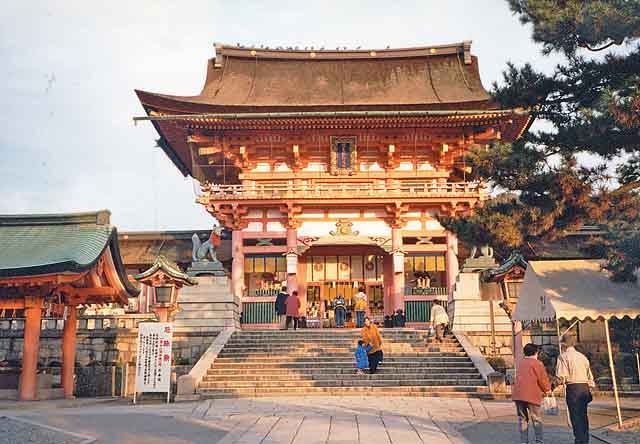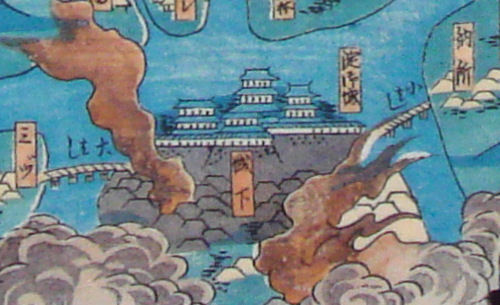|
Yodo-juku
was the second station on the Ōsaka Kaidō (or fifty-fifth of the fifty-seven stations of the Tōkaidō). It is located in the southern part of Fushimi-ku in the present-day city of Kyoto, Kyoto Prefecture, Japan. History Located between the Yodo and Katsura rivers, Yodo-juku was founded in 1619. During the Edo period, it was part of the castle town that surrounded Yodo Castle, which was constructed in 1623. Neighboring Post Towns ;Ōsaka Kaidō (extended Tōkaidō) : Fushimi-juku – Yodo-juku – Hirakata-juku was the third station on the Ōsaka Kaidō (or fifty-sixth of the fifty-seven stations of the Tōkaidō). It is located in the present-day city of Hirakata, Osaka Prefecture, Japan. It flourished as a port along the Yodo River and traces of the ... References {{coord missing, Kyoto Prefecture Stations of the Tōkaidō History of Kyoto Prefecture ... [...More Info...] [...Related Items...] OR: [Wikipedia] [Google] [Baidu] |
Fushimi-juku (Tōkaidō)
was the first station on the Tōkaidō (road)#Ōsaka Kaidō, Ōsaka Kaidō (or fifty-fourth of the 53 Stations of the Tōkaidō#Ōsaka Kaidō, fifty-seven stations of the Tōkaidō (road), Tōkaidō). It is located in Fushimi-ku, Kyoto, Fushimi-ku in the present-day city of Kyoto, Kyoto Prefecture, Japan. History Fushimi-juku was founded in 1619. It was a successful post station because it also shared the area with the castle town surrounding Fushimi Castle, as well as Fushimi Port on the Yodo River. Neighboring Post Towns ;Ōsaka Kaidō (extended Tōkaidō) :Ōtsu-juku – Fushimi-juku – Yodo-juku {{DEFAULTSORT:Fushimi-juku (Tokaido) Stations of the Tōkaidō History of Kyoto Prefecture ... [...More Info...] [...Related Items...] OR: [Wikipedia] [Google] [Baidu] |
53 Stations Of The Tōkaidō
The are the rest areas along the Tōkaidō, which was a coastal route that ran from Nihonbashi in Edo (modern-day Tokyo) to Sanjō Ōhashi in Kyoto.. There were originally 53 government post stations along the Tōkaidō, where travelers had to present traveling permits at each station if wanting to cross. In 1619, the Ōsaka Kaidō (大阪街道) was developed to extend the Tōkaidō so that it would reach Kōraibashi in modern-day Osaka. Instead of going to Sanjō Ōhashi, travelers would leave from Ōtsu-juku and travel towards Fushimi-juku. Because of the addition of these four post towns, the Tōkaidō is occasionally referred to as having 57 stations. Another name for this extension was Kyōkaidō (京街道). The inland Nakasendō also started at Nihonbashi, and converged with the Tōkaidō at Kusatsu-juku. Shio no Michi intersected with the Tōkaidō at Okazaki-shuku. Stations of the Tōkaidō See also * Edo Five Routes ** 69 Stations of the Nakase ... [...More Info...] [...Related Items...] OR: [Wikipedia] [Google] [Baidu] |
Hirakata-juku
was the third station on the Ōsaka Kaidō (or fifty-sixth of the fifty-seven stations of the Tōkaidō). It is located in the present-day city of Hirakata, Osaka Prefecture, Japan. It flourished as a port along the Yodo River and traces of the post town can still be seen today. History Hirakata was formed in 1596, under the order of Toyotomi Hideyoshi. Though initially developed for other purposes, it became a post town when Tokugawa Ieyasu extended the Tōkaidō with the creation of the Ōsaka Kaidō in 1601.History of Hirakata-shuku . Hirakata-shuku Machikyo. Accessed December 3, 2007. In 1758, it was said that the Tōkaidō extended from to |
Yodogawa 1
Yodogawa (written: 淀川) is a Japanese surname. Notable people with the surname include: *, Japanese film critic and television personality *, Japanese footballer See also * Yodogawa-ku, Osaka is one of 24 wards of Japan, wards of Osaka, Japan. It is located in the north of the city. Economy Nissin Foods has its corporate headquarters in Yodogawa-ku. The company moved to its current headquarters in 1977, when the construction of the b ..., Japan * The Yodo River in Japan {{surname, Yodogawa Japanese-language surnames ... [...More Info...] [...Related Items...] OR: [Wikipedia] [Google] [Baidu] |
Tōkaidō (road)
The , which roughly means "eastern sea route," was the most important of the Five Routes of the Edo period in Japan, connecting Kyoto to Edo (modern-day Tokyo). Unlike the inland and less heavily travelled Nakasendō, the Tōkaidō travelled along the sea coast of eastern Honshū, hence the route's name. Traveling the Tōkaidō The standard method of travel was on foot, as wheeled carts were almost nonexistent and heavy cargo was usually sent by boat. Members of the higher class, however, travelled by ''kago''. Women were forbidden to travel alone and had to be accompanied by men. Other restrictions were also put in place for travellers, but, while severe penalties existed for various travel regulations, most seem not to have been enforced. Captain Sherard Osborn, who travelled part of the road in around 1858, noted that: Along the Tōkaidō, there were government-sanctioned post stations (shukuba) for travellers' rest. These stations consisted of porter stations and horse ... [...More Info...] [...Related Items...] OR: [Wikipedia] [Google] [Baidu] |
Fushimi-ku, Kyoto
is one of the eleven Wards of Kyoto, wards in the Municipalities of Japan, city of Kyoto, in Kyoto Prefecture, Japan. Famous places in Fushimi include the Fushimi Inari Jinja (shrine), Shrine, with thousands of torii lining the paths up and down a mountain; Fushimi Castle, originally built by Toyotomi Hideyoshi, with its rebuilt towers and gold-lined tea-room; and the Teradaya, an inn at which Sakamoto Ryōma was attacked and injured about a year before his assassination. Also of note is the Gokōgu shrine, which houses a stone used in the construction of Fushimi Castle. The water in the shrine is particularly famous and it is recorded as one of Japan's 100 best clear water spots. Although written with different characters now, the name Fushimi (which used to be its own "town") originally comes from ''fusu'' + ''mizu'', meaning "hidden water" or "underground water". In other words, the location was known for good spring water. The water of Fushimi has particularly soft characteris ... [...More Info...] [...Related Items...] OR: [Wikipedia] [Google] [Baidu] |
Kyoto
Kyoto (; Japanese: , ''Kyōto'' ), officially , is the capital city of Kyoto Prefecture in Japan. Located in the Kansai region on the island of Honshu, Kyoto forms a part of the Keihanshin metropolitan area along with Osaka and Kobe. , the city had a population of 1.46 million. The city is the cultural anchor of a substantially larger metropolitan area known as Greater Kyoto, a metropolitan statistical area (MSA) home to a census-estimated 3.8 million people. Kyoto is one of the oldest municipalities in Japan, having been chosen in 794 as the new seat of Japan's imperial court by Emperor Kanmu. The original city, named Heian-kyō, was arranged in accordance with traditional Chinese feng shui following the model of the ancient Chinese capital of Chang'an/Luoyang. The emperors of Japan ruled from Kyoto in the following eleven centuries until 1869. It was the scene of several key events of the Muromachi period, Sengoku period, and the Boshin War, such as the Ōnin War, the Ho ... [...More Info...] [...Related Items...] OR: [Wikipedia] [Google] [Baidu] |
Yodo River
The , also called the Seta River (瀬田川 ''Seta-gawa'') and the Uji River (宇治川 ''Uji-gawa'') at portions of its route, is the principal river in Osaka Prefecture on Honshu, Japan. The source of the river is Lake Biwa in Shiga Prefecture to the north. The Yodo River, usually called the Seta River in Shiga Prefecture, begins at the southern outlet of the lake in Ōtsu. There is a dam there to regulate the lake level. Further downstream, the Seta flows into Kyoto Prefecture and its name changes to the Uji River. It then merges with two other rivers, the Katsura River and the Kizu River in Kyoto Prefecture. The Katsura has its headwaters in the mountains of Kyoto Prefecture, while the Kizu comes from Mie Prefecture. From the three-river confluence, the river is called the Yodo River, which flows south, through Osaka, and on into Osaka Bay. In Osaka, part of the river has been diverted into an artificial channel; the old course in the heart of Osaka is called the Kyū-Yodo ... [...More Info...] [...Related Items...] OR: [Wikipedia] [Google] [Baidu] |
Katsura River
The is a continuation of two other rivers, the Hozu River, a small, speedy river which begins in the mountains near Kameoka and then slithers through the mountains separating Kameoka and Kyoto; and the Ōi River (大堰川 ''Ōi-gawa''), which emerges from those mountains and expands into a shallow, slow-flowing river until Togetsukyo Bridge in Arashiyama. From that point forward, the river is referred to as the Katsura River, and its flow continues for several kilometers through Kyoto Prefecture until it joins the Kamo and Uji rivers. The Katsura River area features some of the oldest shrines in Kyoto and Japan, such as Matsuo Shrine, and, as a counterpoint to the channelled Kamo River, supports acres of agricultural area on its flood plain. It also is known for its summer supply of '' ayu'' and is a popular place for holding barbecues. See also * Katsura, Kyoto Katsura (桂) is a neighborhood in Nishikyo-ku, in the western part of the city of Kyoto, Japan. Predominant ... [...More Info...] [...Related Items...] OR: [Wikipedia] [Google] [Baidu] |
Edo Period
The or is the period between 1603 and 1867 in the history of Japan, when Japan was under the rule of the Tokugawa shogunate and the country's 300 regional '' daimyo''. Emerging from the chaos of the Sengoku period, the Edo period was characterized by economic growth, strict social order, isolationist foreign policies, a stable population, perpetual peace, and popular enjoyment of arts and culture. The period derives its name from Edo (now Tokyo), where on March 24, 1603, the shogunate was officially established by Tokugawa Ieyasu. The period came to an end with the Meiji Restoration and the Boshin War, which restored imperial rule to Japan. Consolidation of the shogunate The Edo period or Tokugawa period is the period between 1603 and 1867 in the history of Japan, when Japan was under the rule of the Tokugawa shogunate and the country's regional '' daimyo''. A revolution took place from the time of the Kamakura shogunate, which existed with the Tennō's court, to the Tok ... [...More Info...] [...Related Items...] OR: [Wikipedia] [Google] [Baidu] |
Yodo Castle
The was a Japanese domain of the Edo period, and the only domain located in Yamashiro Province. Its castle was located within modern-day Fushimi, Kyoto. The strategic location of the castle figured in the 1582 Battle of Yamazaki. During the 1868 Battle of Toba–Fushimi, the master of Yodo changed his allegiance from the Shogunate to Imperial forces, going as far as closing his gate and refusing protection to the retreating army of the ''shōgun'' Tokugawa Yoshinobu. List of lords * Matsudaira (Hisamatsu) clan ( Shinpan; 35,000 koku) #Sadatsuna *Nagai clan ( Fudai; 100,000→736,000 koku) # Naomasa #Naoyuki *Ishikawa clan ( Fudai; 60,000 koku) #Noriyuki #Yoshitaka #Fusayoshi * Matsudaira (Toda) clan ( Fudai; 60,000 koku) #Mitsuhiro #Mitsuchika * Matsudaira (Ogyū) clan ( Fudai; 60,00 koku) #Norisato *Inaba clan ( Fudai; 102,000 koku The is a Chinese-based Japanese unit of volume. 1 koku is equivalent to 10 or approximately , or about . It converts, in turn, to 1 ... [...More Info...] [...Related Items...] OR: [Wikipedia] [Google] [Baidu] |


.jpg)



